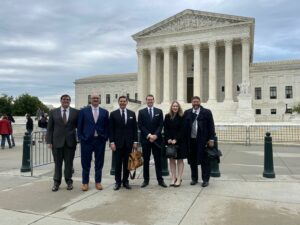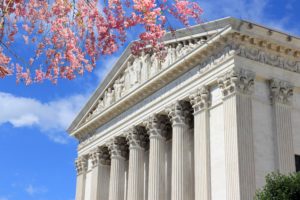Discourse: Restoring the Rule of Law

Since the Supreme Court decided Sackett v. Environmental Protection Agency on May 25, some commentators have been pushing a regrettable narrative, about how an “activist” and “anti-science” court bucked “expert” regulators to gut the Clean Water Act and pollute our nation’s wetlands. Pardon the pun, but such criticism is a load of sewage.
We work for Pacific Legal Foundation, which has represented the Sackett family for the better part of two decades, and we’d like to clean the rhetorical waters. Sackett is not just a significant environmental law decision. It is a landmark victory for civil rights and the rule of law. In Sackett, the court (finally) answered a question that had troubled landowners for almost half a century: When can federal officials regulate wet earth under the Clean Water Act? For nearly 50 years, no one knew the answer, and this uncertainty was an affront to the rule of law.
Consider the stakes. If your land falls within the Clean Water Act’s ambit, you need a federal permit to develop the property. Estimates of cost range anywhere from $39,000 (government estimate) to $2,376,800 (private sector estimate). What’s more, property owners who even unintentionally violate the act face severe criminal penalties. On the civil side, the government can pursue up to $60,000 in fines per day for each violation. Given these consequences, justice demands clarity on the law’s limits, not just so that landowners may enjoy their property, but also so they can avoid inadvertently becoming felons.
When the Clean Water Act was passed, in 1972, Congress chose to impose a clear limitation on the authority of the agencies that enforce the act—the Environmental Protection Agency and the Army Corps of Engineers. The authority of these agencies to regulate, Congress stated, extends to the “navigable waters,” defined as the “waters of the United States,” and no further.
Unfortunately, EPA and the Army Corps shrugged off the limitations placed upon their authority and instead embarked upon a never-ending expansion of their own power. Within just a decade, the agencies believed they could regulate—and punish people civilly and criminally—for activities conducted in and around every ditch, wetland, pool and puddle in the country.
Consider the “significant nexus” test, for many years the agencies’ prevailing method for identifying what exactly “waters of the United States” covers under the act. Under this framework, the agencies interpreted their authority to reach wetlands that share a “hydrological, chemical, or biological connection” with navigable water. In practice, discerning a “significant nexus” from an insignificant nexus was a judgment call made by the regulators on a case-by-case basis. According to the agencies, “almost all waters and wetlands” were susceptible to regulation. Anyone with a puddle on their property was potentially liable, but you couldn’t know for sure until the government told you.
In 2004, Chantell and Mike Sackett purchased a small lot near Priest Lake, Idaho, with the intention of building a home. Shortly after starting construction, however, federal officials entered and ordered that all work cease. EPA followed up by claiming that moist patches on the property, when aggregated with “similarly situated” patches on the other side of a 30-foot-wide paved road, together bear a “significant nexus” to Priest Lake, itself separated from the Sacketts’ lot by a paved road and a row of houses. One could forgive the Sacketts for being surprised.
The Sacketts, like countless others in their unhappy situation, were threatened with steep fines to coerce “voluntary” compliance, a practice the Supreme Court called “strong-arming.” Then the regulators resorted to what the Eighth Circuit has described as a “transparently obvious litigation strategy” of forcing the regulated party to endure “prohibitive costs, risk, and delay.” After 16 years of litigation, the Sacketts prevailed last month when the Supreme Court unanimously rejected the significant nexus test. The couple is finally free to do what they want with their property.
After decades of uncertainty, the majority on the court finally issued a definitive interpretation of “waters of the United States.” The court set forth a test designed to give landowners long-overdue certainty. From now on, wetlands are subject to draconian federal regulation only if they share a continuous surface water connection with a permanent and continuously flowing body of water. That’s something you can identify without hiring a hydrologist.
Accusations that the court is “anti-science” miss the mark. The critics pine for the supposedly scientific “significant nexus” test, but guess where that framework came from? It was created by a single justice of the Supreme Court, in a prior opinion, and then co-opted and expanded by the EPA and Army Corps, which recognized its limitless potential.
More generally, the majority in Sackett based its interpretation on well-established interpretive principles like federalism; the “rule of lenity,” which requires ambiguous criminal statutes to be interpreted in ways that clarify what is prohibited; and other due process protections—concepts that fall squarely within the court’s expertise. To the majority, it was patently unfair to leave landowners in the dark any longer about their potentially criminal liability.
As for the charges of “judicial activism,” it’s worth putting this decision in historical perspective. In one important sense, Sackett is analogous to Miranda v. Arizona, which some decried as an instance of judicial activism since it announced a rule that went further than resolving the case at hand, but provided great clarity in countless arrests to follow. (The reading of a suspect’s “Miranda rights” should be familiar to anyone who watches police shows.)
The difference is that the Supreme Court took a greater leap in Miranda in fashioning a prophylactic constitutional rule to prevent coerced confessions that no one could alter, whereas the court in Sackett interpreted a statutory term, “waters of the United States,” that had been in dispute for 50 years to mean “something that looks like water,” which Congress can change if it wants to do so.
And yet, Miranda and Sackett are alike in another sense: They both secured significant protections against unfair criminal prosecutions based on age-old due process and criminal law principles. That’s something progressives celebrated in cases like Miranda. Americans should celebrate Sackett as a landmark civil rights victory for the same reason.
This op-ed was originally published at Discourse Magazine on June 21, 2023.








